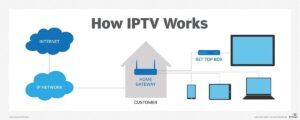Understanding IPTV: Revolutionizing Television Viewing
In an era dominated by digital innovation, traditional television broadcasting methods are being gradually supplanted by cutting-edge technologies that offer greater flexibility and convenience. One such innovation is IPTV, an acronym for Internet Protocol Television. IPTV represents a paradigm shift in the way television content is delivered and consumed, leveraging the power of the internet to revolutionize the viewing experience.
What is IPTV?
IPTV is a system through which television services are delivered using the Internet Protocol (IP) suite over a packet-switched network, such as the internet. Unlike traditional methods of television delivery, which rely on terrestrial, satellite, or cable networks, IPTV utilizes broadband internet connections to transmit television signals to viewers’ devices.
How Does IPTV Work?
At its core, IPTV involves the encoding of television content into IP packets, which are then transmitted over the internet to users’ devices. These devices can include smartphones, tablets, computers, smart TVs, and set-top boxes. Upon receiving the IP packets, the user’s device decodes the content and displays it on the screen in real-time.

Features of IPTV
One of the key features of IPTV is its versatility and flexibility. Unlike traditional television broadcasting, which follows a linear schedule, IPTV allows users to access content on-demand. This means that users can watch their favorite shows, movies, and sporting events whenever they want, rather than being constrained by broadcast schedules.
Additionally, IPTV services often offer a wide range of channels and content options, catering to diverse tastes and preferences. Users can choose from live TV channels, on-demand movies and TV shows, and even interactive features such as video-on-demand (VOD), time-shifted TV, and digital video recording (DVR).
Benefits of IPTV
IPTV offers several advantages over traditional television broadcasting methods. Firstly, it provides greater accessibility, allowing users to watch television content on a variety of devices and platforms. Whether at home or on the go, users can enjoy their favorite shows and movies with ease.
Furthermore, IPTV offers enhanced interactivity and personalization features. Through features such as VOD and DVR, users can tailor their viewing experience to suit their preferences, pausing, rewinding, or recording live TV as desired. This level of control empowers users to consume content on their own terms, enhancing the overall viewing experience.
Conclusion
In summary, IPTV represents a significant advancement in the field of television broadcasting, offering users greater flexibility, accessibility, and control over their viewing experience. By harnessing the power of the internet, IPTV has transformed the way we consume television content, paving the way for a more interactive and personalized entertainment experience.
As the technology continues to evolve and improve, IPTV is poised to play an increasingly prominent role in the future of television, shaping the way we watch, interact with, and enjoy our favorite shows and movies.

